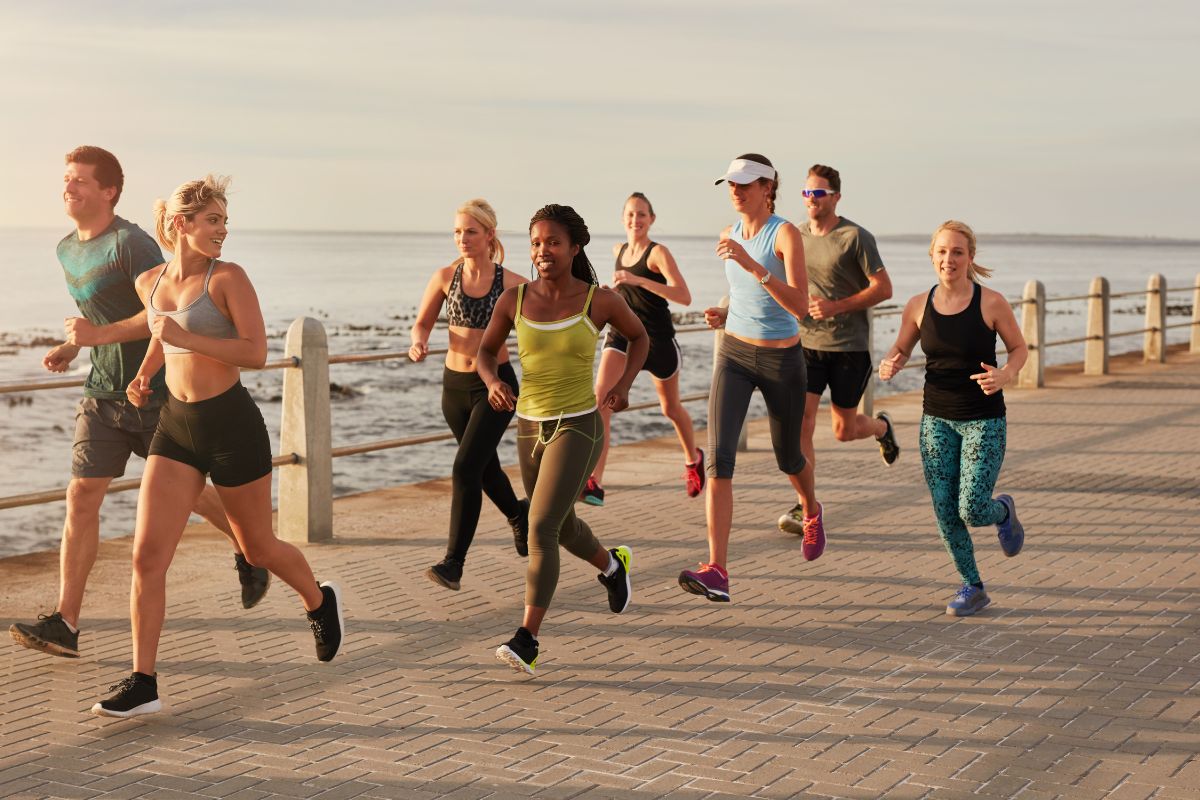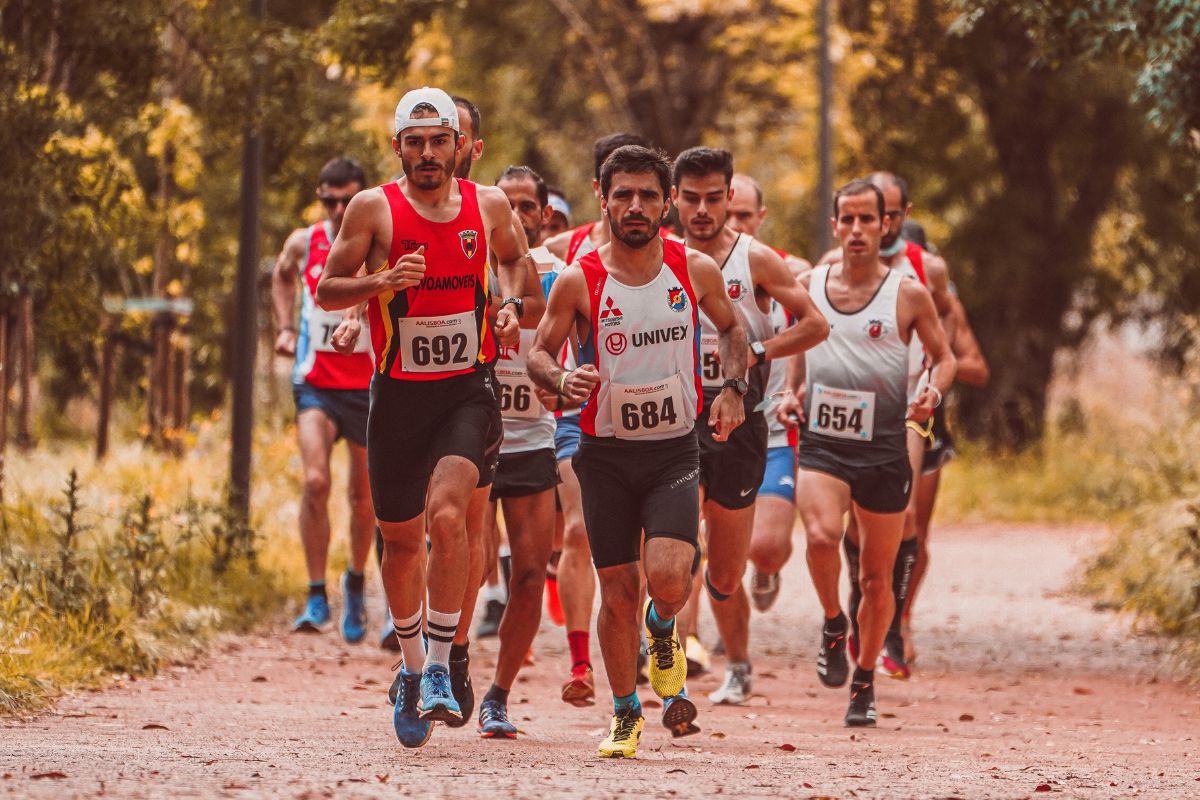You might have mastered running that 5K all the way through without stopping but your time is not quite race ready.

Or you may just be looking for ways to extend the length of time you can run faster than a job. These are common goals of runners from beginners all the way to veteran marathon runners.
Learning to pick up the pace and maintain it for a longer period of time takes effort, patience and practice. The only way to get there is to remain consistent in your training.
You may need to mix up your training regimen and push yourself outside of your comfort zone if you have trouble keeping a steady pace while running or notice that your speed fluctuates throughout your training.
Well you’re in luck! In this guide you’ll find 8 ways to help you run faster for longer without burning out too quickly.
Keep reading to find out how you can up the pace and win the race!
How To Run Faster
It’s common to focus on the distance you want to complete as you set out your goals for your run. And it’s a good way to keep you focused.
However, once you achieve that distance and can do it comfortably, where do you go?
Now it’s time to increase the pace and bring down your time to complete your run.
Whether it’s a simple mile, a healthy 5K or a daunting marathon, getting your time down will only benefit you in the long run.
Distance running is perfect to improve your stamina and endurance but it wont bring down your time.
There should be a focus on speedwork and workouts that involve high bursts of movements such as weightlifting and interval training.
8 Ways To Run Faster
In this guide you’ll find 8 tips to help you run faster for longer. From before you even hit the pavement all the way to your mental structure.
You’ll see yourself running faster than ever before.
1. Warm Up
Before you even leave the house, a warm up routine is imperative for not only running faster but to prevent injury.
You’ll feel more physically and mentally prepared for your run after your warm up routine and rather hyped to get going.
Your warm up routine should be completed around 10 to 15 minutes before you start your run. This will get the blood flowing to your muscles and increase flexibility to your joints during your run.
The mobility and fluidity you will feel after your warm up will help propel you forward to increase your speed throughout your run.
You’ll find yourself less sore after a long run and that you’ll be able to push yourself that much harder without hitting burnout.
2. Improve Running Form
Similar to weightlifting, having the proper form is essential to getting the most out of your training sessions.
Learning a proper running form will let you run more efficiently to lessen the pressure on your muscles and joints.
Take some time in your warm up to practice some running drills to help perfect your forms. Running drills can include:
- Butt kicks
- High knees
- Forward lunge
- Quick feet
These will give your body and mind the basics to perfect your running form.
Thinking about the strides you take will also help improve your form. Short bursts of fast running are called strides.
They are simple to incorporate into your training program because they may be done at any point throughout a run, including the beginning, middle, and end.
Starting with a light jog in your warm up can allow you to concentrate on how you can implement strides into your full run.
One stride should take you around 20-30 seconds depending on your running level.
Involving strides throughout your run will allow short bursts of increased speed to bring down your time and increase your stamina.

3. Practice Speedwork
Having impeccable speedwork will help you run faster and gain more power during your runs.
Taking time outside of your runs to concentrate on your speedwork will make you work harder and become healthier in general as your cardiovascular muscles improve.
There are various forms of speedwork sessions including:
- Interval training. This is a training method which combines short, intense bursts of speed with slow recovery periods. This can look like running full speed on a treadmill for 30 seconds to then walk for 1 minute. Completing for 10-15 rounds. Interval training can help you become a better runner by increasing your speed, strength, and endurance if you perform it frequently as part of an organized training program.
- Tempo running. This is also known as a ‘threshold run’. Running at a pace roughly 25 to 30 seconds slower than your average 5K pace. It is designed to be challenging as your mind wants to push forward. You should be able to complete a tempo run for around 20 minutes without feeling tired.
- Fartlek training. Swedish for ‘speed play’ this workout blends the characteristics of distance running and interval training. This session will involve running continuously faster than you would regularly to then slow down to a nice, comfortable pace. This is a great way to see results when short on time.
Working on your speedwork is one of the most important elements to being able to run faster for longer.
Spend extra care on these workouts as they may seem more challenging than your regular running sessions.
4. Practice Pacing
Pacing, or your running pace, is the speed in which you run a mile or kilometer during a longer run.
Finding out your pace is helpful when training for a big run or race as you can then begin training to bring down your overall time.
For instance, if you run 10k in 45 minutes, your pace is 4.30 minutes per kilometer, or 7.15 minutes per mile.
Using a running pace calculator will give you accurate times for your pace. You can then work on increasing your pace on your next run.
Learning your average pace is great if you’re a fan of tempo running. You’ll learn how to run for longer distances without feeling burnout too quickly.
Perfecting your pacing is not only about bringing down the time on the watch but working on your breathing. As you watch others run you’ll notice that they have found a breathing pattern.
This maximizes the amount of air entering their lungs to allow them to run for longer without getting too out of breath.
A common breathing pattern is inhale for 3 foot strikes and exhale for 2. Others use rhythmic breathing which is where you breathe into your belly instead of your chest.
Remember to breathe in through the nose and out through the mouth as solely breathing through the mouth can cause a hyperventilating effect.
Try it out on your next run to find out if you just needed to work on your breathing!
5. Strength Training Sessions
While running is a cardiovascular activity, weight or strength training is still an important element to include in your training regime.
Strength training with the goal of improving your running should include bodyweight exercises, dumbbells, kettlebells or medicine balls.
This type of training specializes in strength building, anaerobic endurance and bone density.
Strength training will help build muscles throughout the body, specifically the legs which have the most load bearing during running.
Working on these muscles will in turn help protect the joints, ligaments and tendons during shock absorption which takes place as you land during running.
Essentially strength training will decrease your probability of injury during your runs.
Building the glutes, hamstrings and calf muscles will increase your power and propel you forward to increase your speed.

6. Mental Training
Running across long distances is not only physically challenging but mentally difficult as well. It’s important to ensure your mind is mentally strong enough to complete the run just as much as your body is.
No matter the race distance, every runner has at some point felt the tension between the need to move forward and the growing desire to quit.
As you grow more exhausted throughout your run, your mind will be the first to tell you to stop. As your mind becomes fatigued, your effort will be impacted.
This can make you want to quit, slow down and overall increase your time as you continue the battle between your body and mind.
Before beginning your run give yourself a pep talk. Hyping yourself up and talking to yourself in a positive tone can do wonders when it comes to running faster for longer.
Boost your own confidence and self-esteem by having a strong pep talk before you set out.
Set yourself a reward for after your run. This can be as simple as a steaming cup of coffee or a long, bubbly hot bath to relax the muscles.
Having a post-run reward will give you the motivation to push through the negative thoughts that appear at the end of your run.
A top tip which is used by many professional runners is to practice visualization.
Mentally visualizing yourself running over the finish line or beating your time from your previous run can help you reach the goals you have set for yourself.
Set aside the time to be kind to your body and your mind. Not taking care of your mental health will hinder you from reaching your goals.
7. Find Community
Running alone can become isolating after a while. Joining a friend on a run or joining a running club can be a great way to socialize and meet new people who have similar goals and interests.
However, finding a friend or club which has the same experience as yourself is key. You want to be surrounded by people who take the pressure off running yet push you to achieve your goals.
A variety of sessions catered to various skill levels are offered by several groups.
Join a group that offers many sorts of training, not just simple, long, steady runs, if your objective is to run faster for longer.
If you’re serious about bringing down your time, research running coaches may be the next step for you. The knowledge and experience of a certified running coach are priceless.
They will also be able to offer advice on optimal training schedules as well as matters like recovery and diet.
Not to mention, it will keep running fun and exciting!

8. Consistency
We all know the saying, consistency is key. This is crucial when working on picking up your pace during your runs.
Pushing yourself that little bit harder, adding in those strength training sessions and working on your speedwork will all pay off when you see that time come down.
You won’t see results immediately. It takes time and work to run faster for longer. So seeing small, gradual improvements over a longer period of time is great!
Keep your eye on the prize and don’t get discouraged when you don’t see immediate improvement.
This means sticking to your training program, having a healthy balanced diet and taking rest days when you need them.
You should not be running every day of the week as this can hinder your progress rather than help. Take time to recover between runs to let your muscles relax and rebuild.
Being consistent with your training and rest will strengthen your mind along with your body. You’ll feel stronger allround and see improvements to your speed and distance as you continue to train.
Final Thoughts
Running faster for longer can be a hard target to hit. Whether for a race or just to up the ante on your runs, it takes a lot of time and effort to achieve.
Including strength training workouts will help you immensely. As you begin to develop your muscles, you’ll find yourself running with ease.
There is also the added benefit of protecting your bones and joints. Whether you include a home bodyweight workout or get a gym membership, you’ll only see benefits.
One of the most important ways to help increase your pace is to work on your speedwork.
Whether you enjoy the high intensity workout of interval training or the mentally challenging work of tempo training, you’ll find yourself being able to run faster for longer in just a few weeks!
Now it’s time for you to get your running shoes on, complete that all important warm up and hit the track.
Practice your strides, give yourself that pep talk and run faster for longer!
- Can Dogs Run Faster Than Humans? (Running With Your Furry Friend) - October 4, 2022
- 10 Doggie Fun Runs You Will Love [Ultimate Guide] - October 4, 2022
- What Are Division Results In Running? - October 4, 2022








